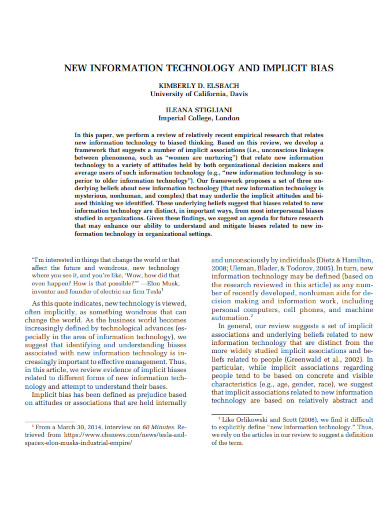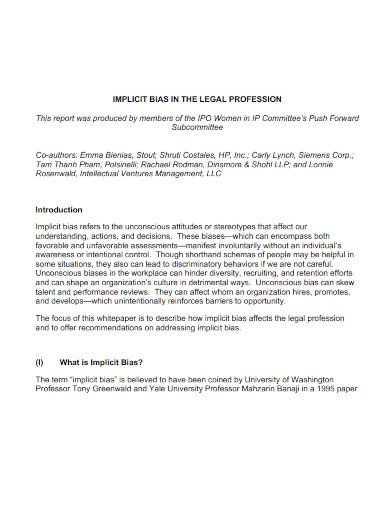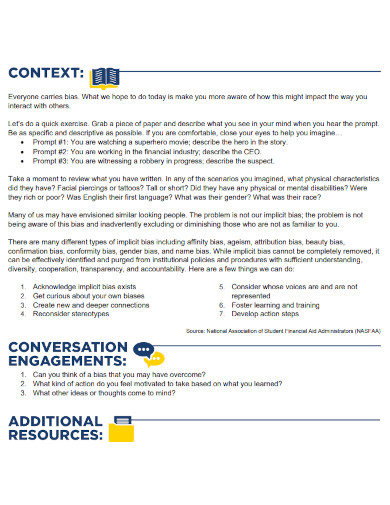18+ Implicit Bias – Examples, PDF Examples to Download
Everyone has their predisposed notions about specific contexts, themes, tones, and ideas of various entities and objects. This predisposed notion will affect a person’s thoughts and actions, which will often lead to discrimination, fallacy, harm, or bias. When a person acts on the bias, people consider them as having implicit bias.
1. Implicit Bias and Structural Inequity
2. Defining Implicit Bias Example
3. Combating Implicit Bias and Stereotypes
4. Understanding Implicit Bias
5. New Information Technology And Implicit Bias
6. Implicit Bias in Legal Profession
7. Implicit Bias and Policing
8. Implicit Bias Training Facilitator Guide
9. Implicit Bias in Mediation Example
10. Implicit Bias’s Failure Example
11. Implicit Bias in the Courtroom
12. Implicit Bias and Cultural Sensitivity
13. Addressing Implicit Bias in Nursing
14. Implicit Bias Series Example
15. Responsibility for Implicit Bias
16. Implicit Bias Instructions
17. Managing Implicit Bias
18. Challenging Implicit Bias
19. Implicit Bias in Healthcare
What Is Implicit Bias?
Implicit bias is a type of bias that occurs when predisposed ideas will unintentionally affect someone’s thoughts, perceptions, or actions. There are various elements, like stereotypes and archetypes, that come into play in implicit bias. Due to implicit bias’ unintentional nature and context, it is very hard to distance ourselves from this type of bias.
How to Minimize Implicit Bias
It is important to try and minimize one’s implicit bias as this type of thinking can unintentionally harm a person through one’s actions and decisions. There are many ways a person can reduce the influence of their implicit bias, but it cannot be eliminated in one’s life as this bias is inherent in the human experience.
Step 1: Increase One’s Awareness of Stereotypes
Stereotypes and implicit bias often go hand in hand, as the former will often be the main reason why the person commits implicit bias. Therefore one can reduce or minimize implicit bias by increasing one’s awareness and proclivity toward stereotypes.
Step 2: Get to Know More People of Different Backgrounds
One of the best ways to reduce implicit bias is to get to know more people without different backgrounds, ethnicities, ethnic groups, cultures, races, and social standing. By getting to know more people that are different from yourself, you will be able to improve your predisposed notions of people who hail from different groups and minimize occurrences of implicit bias.
Step 3: Become More Mindful or Practice Mindfulness
One can minimize occurrences of implicit bias by becoming aware of one’s environment, actions, and thoughts. By practicing mindfulness in one’s everyday actions, the person can unconsciously be mindful of the impact their actions, decisions, and words have on the people around them
Step 4: Practice Empathy
Empathy is a soft skill that allows the person to relate with another entity and see themselves in the other person’s shoes despite the limitations of our human experience. Practicing empathy will not only reduce one’s chances of committing implicit bias, but it will also improve one’s ability to maintain and create long-lasting relationships.
FAQs
The hiring manager or HR should create and conduct decisions that are highly logical and should be objective. This is to ensure that the hiring manager or HR will make good decisions on the people they will hire and incorporate into the business or company. Not only will this ensure the success of the company, but it will also improve the overall outputs and flow of the company as a whole.Why should the hiring manager or the HR minimize implicit biases in their decisions?
Implicit bias is dangerous because it can potentially harm and isolate a person from their peers. This will result in physical injuries and a reduction in the said person’s mental and emotional health, which might end up in fatal or dangerous situations.Why is implicit bias dangerous?
Implicit bias is a type of bias wherein the said person will unconsciously act or create decisions based on a preconceived notion or idea of a person. Explicit bias, on the other hand, is a type of bias wherein the said person will consciously act or conduct decisions based on preconceived notions or ideas, often people call this bias prejudice.Implicit vs. explicit bias; what is the difference between implicit and explicit bias?
Implicit bias is one of the most common types of bias one will face or encounter in everyday life. When a person commits implicit bias it is done unintentionally and sometimes unconsciously, which may result in harming the person’s loved ones. Therefore it is important to minimize one’s use of implicit bias in everyday actions.




















